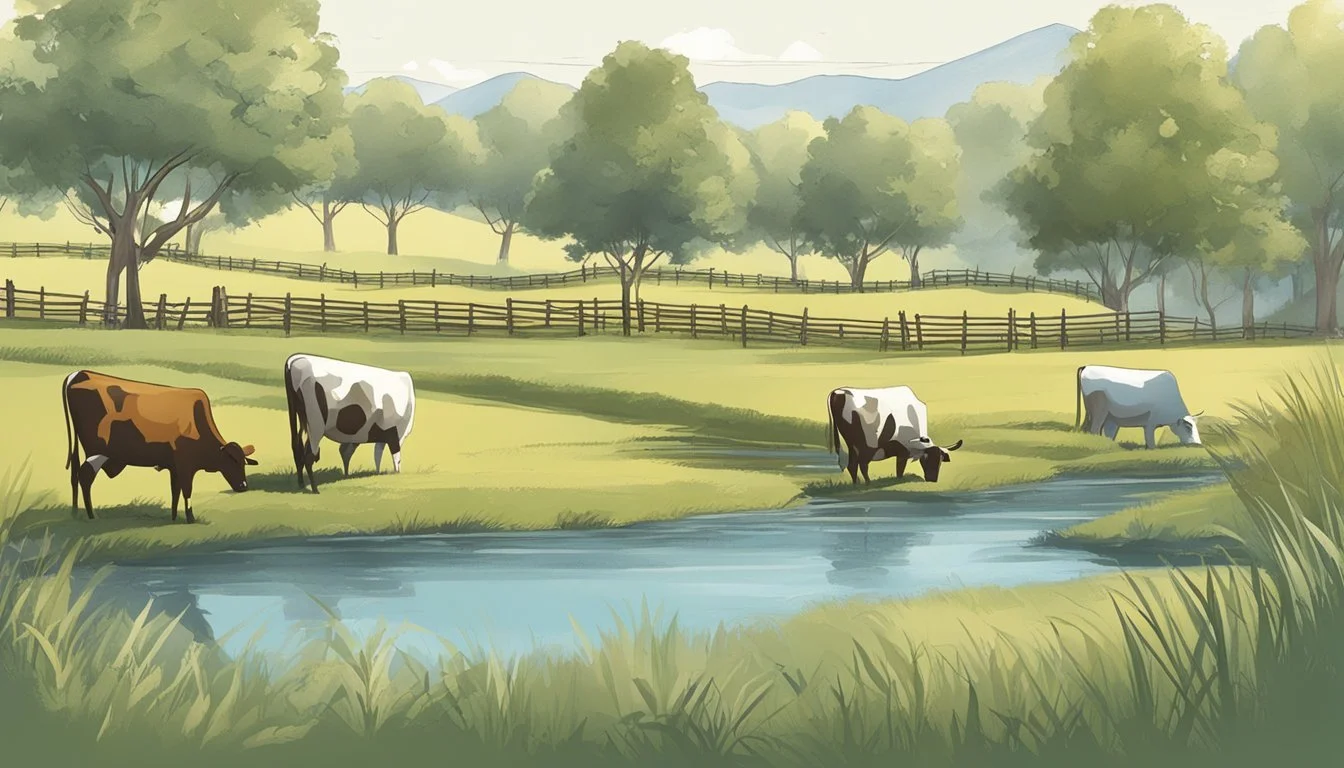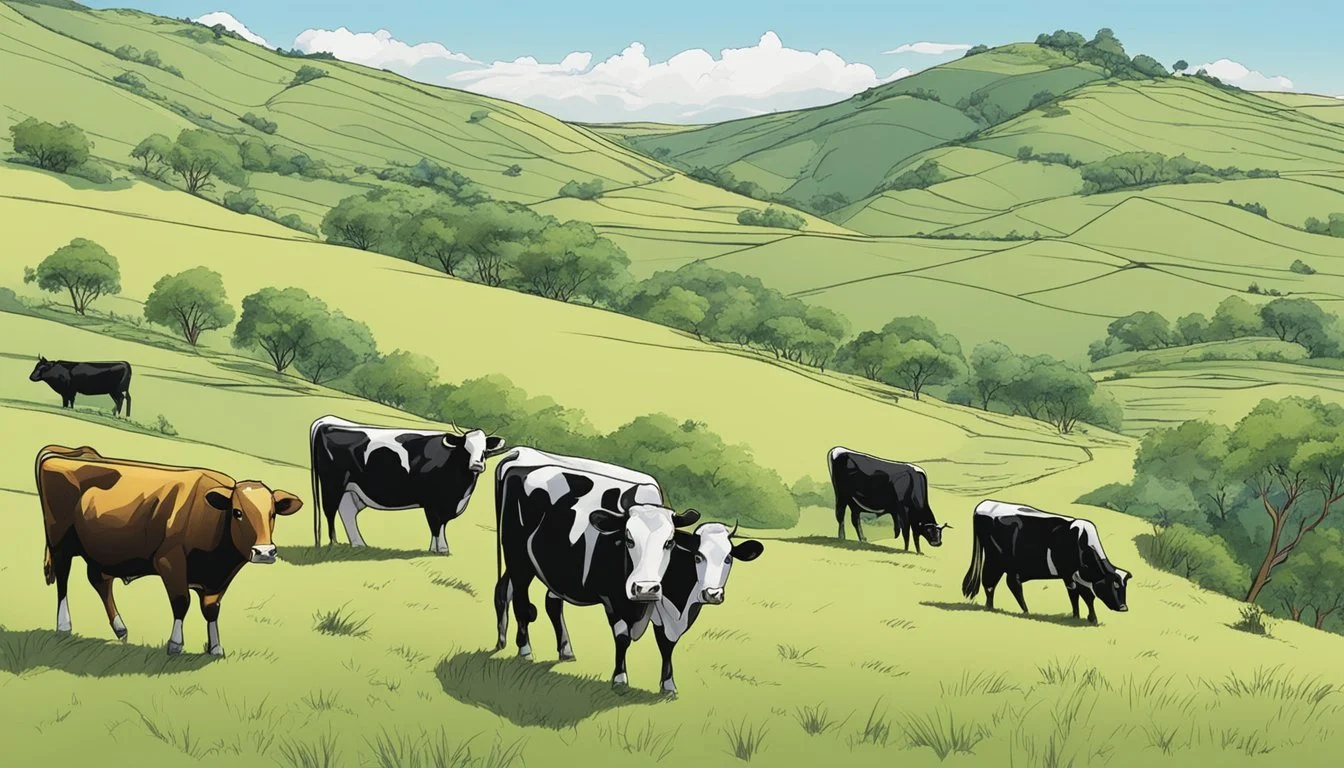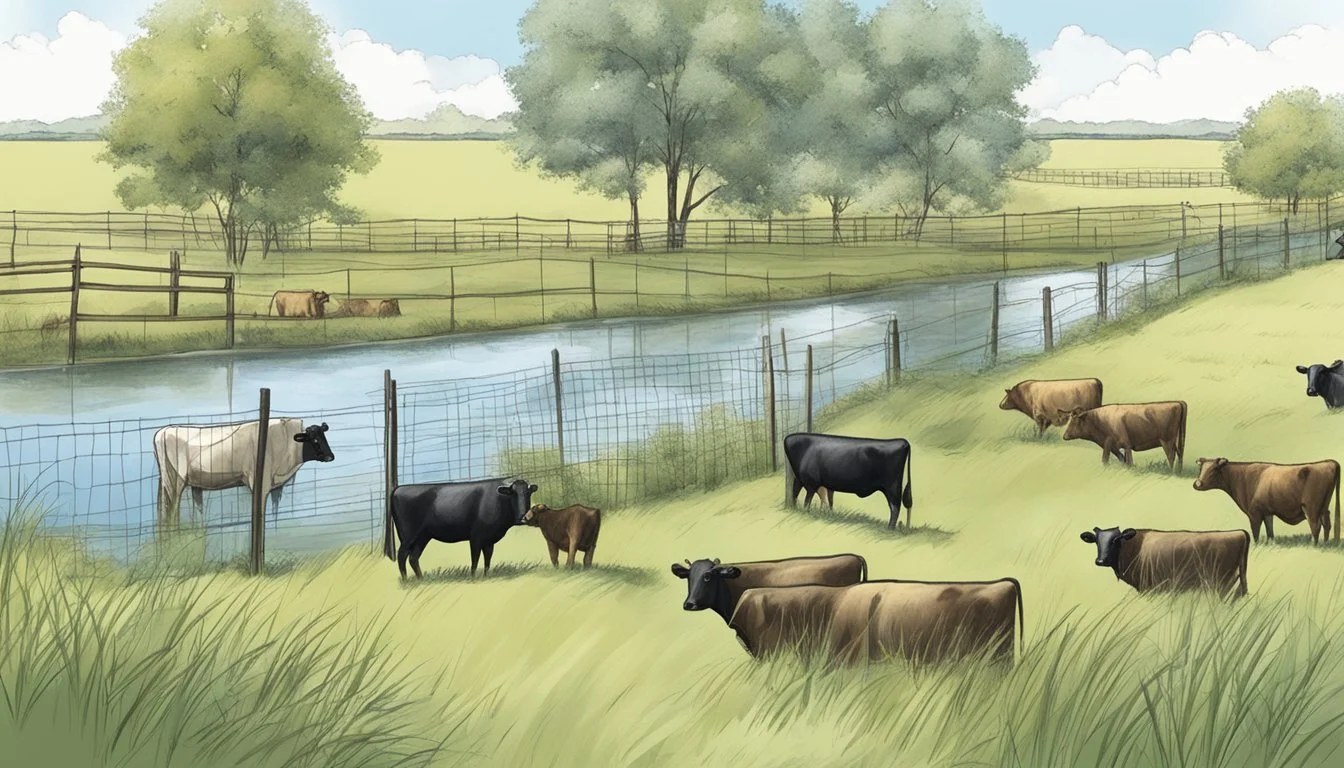How do I Manage Cattle to Prevent Erosion and Runoff
Sustainable Grazing Strategies
Effective management of cattle is crucial for mitigating soil erosion and minimizing water runoff, both of which are essential for maintaining the health and productivity of agricultural lands. It is well documented that mismanagement of livestock can lead to detrimental soil conditions, exacerbating erosion and increasing the loss of nutrient-rich topsoil. To prevent this, it is important to employ strategies that not only preserve the integrity of the soil but also enhance its capacity to absorb and retain water.
Adopting rotational grazing practices is one approach that has been shown to be beneficial. By rotating animals through different pastures, producers can reduce the stress on any one area, allowing vegetation to recover and soil structure to remain intact. Moreover, strategic placement of fencing to control access to sensitive areas, such as waterways, can significantly reduce the likelihood of bank erosion and water contamination.
Another method is to ensure that livestock contribute positively to soil health by enhancing the natural processes that maintain a robust soil ecosystem. This includes understanding the role of cattle in improving soil cover, which can reduce the impact of rain on the soil and decrease the amount of sediment that is carried away by surface runoff. Using cattle to trample tall plants, for instance, can increase soil cover and provide food for soil life, thus fostering a more resilient soil structure capable of combating erosion and runoff.
Understanding Erosion and Runoff
Managing cattle effectively requires a clear understanding of erosion and runoff. Erosion is the process by which soil is worn away, often becoming sediment in water systems, while runoff is water flow that carries these particles away from their original location.
Factors Contributing to Erosion
The primary factors contributing to erosion in pasture lands include rainfall intensity and volume, soil characteristics, land slope, vegetation cover, and cattle movement. Heavy rainfall can dislodge soil particles, especially on steep or bare slopes, where there is insufficient vegetation to hold the soil in place. The impact of cattle hooves on wet soil can also break down the soil structure and contribute to erosion.
Impacts of Runoff on Water Quality
Runoff carries sediment and excess nutrients, like nitrogen and phosphorus, from fields to surface waters. This nutrient runoff can lead to the deterioration of water quality, causing issues such as algal blooms and depletion of oxygen essential for aquatic life. Soil health is compromised as topsoil is eroded, which can reduce the land's productivity and affect water's ability to penetrate and replenish groundwater sources.
Cattle and Pasture Management
Effective pasture management is critical for preventing soil erosion and runoff in cattle farming. A well-designed system not only supports healthy livestock but also protects and enhances soil quality.
Pasture Selection and Slope Considerations
Selecting the right pasture is foundational to managing erosion. Pastures with slopes can be prone to soil erosion, especially if covered in sparse vegetation. When setting up pastures, it is crucial to consider the slope of the land. Gentle slopes are preferable as they are less likely to experience severe runoff. Planting forage species that establish deep root systems can improve soil structure and reduce erosion. These types of forage can also benefit the cattle by providing a nutrient-rich diet.
Furthermore, categorizing land based on its capability to support grazing helps in utilizing marginal lands that are not suitable for crops effectively. Pastures with steep slopes require special management practices, such as establishing paddocks on the contour of the slope to slow water flow and encourage water infiltration into the soil.
Managing Cattle to Protect Soil
To prevent soil degradation and erosion, implementing rotational grazing is essential. This practice involves moving cattle between paddocks to allow forage to recover and minimize soil compaction. Rotational grazing helps maintain a vegetative cover on the land, which is key to protecting the soil from erosion. Additionally, limiting the number of cattle per acre to avoid overgrazing is fundamental. Overgrazing leaves soil exposed and susceptible to both wind and water erosion.
Properly managed grazing can also reduce the concentration of manure in one area, distributing nutrients more evenly and preventing nutrient runoff. Keeping livestock off wet soils and excluding them from stream banks and other sensitive areas can further minimize soil compaction and erosion. The strategic placement of water sources, feeding areas, and mineral supplements can draw cattle across the pasture to graze more uniformly, reducing the impact in any one area.
Soil Conservation Techniques
Effective soil conservation techniques are vital for managing cattle to prevent erosion and runoff. They rely on practices that maintain the soil structure, enhance organic matter retention, and provide continuous ground cover.
Conservation Tillage and Residue Management
Conservation tillage is a method of soil cultivation that leaves the previous year's crop residue, such as leaves, stems, and roots, on the fields before and after planting the next crop. It enhances soil cover, which can dramatically reduce soil erosion and water loss. Reduced tillage systems disturb the soil less than conventional tillage and can therefore help to maintain soil organic matter. Strategic tillage decreases the velocity of water runoff, thereby lessening the soil's erosion potential.
Benefits of conservation tillage include:
Reduction in soil compaction
Preservation of soil moisture
Enhanced soil biodiversity due to less disruption of the soil biota
Employing Cover Crops and Mulches
Integrating cover crops into cattle management systems serves a dual purpose: it protects the soil from erosion and it can provide additional grazing forage. These crops provide a living plant cover that safeguards against soil erosion by wind and water. Moreover, mulches — organic materials spread on the surface of the soil — offer a protective layer that minimizes runoff and adds to the soil’s organic matter as it decomposes.
Common cover crops and mulches include:
Legumes, such as clover, which also fix nitrogen in the soil
Non-leguminous crops, like rye, that serve as effective mulch when cut and left on the field
Using these methods, farmers can nurture healthier soils which support robust cattle grazing systems while concurrently managing water runoff and preventing erosion.
Nutrient Management
Effective nutrient management is essential in preventing erosion and runoff on cattle farms. It ensures manure and fertilizers are utilized to enhance soil productivity while protecting water resources.
Handling Manure and Fertilizers
Manure, rich in nutrients like nitrogen, phosphorus, and potassium, is a vital part of the nutrient cycle on a livestock farm. To prevent erosion and runoff, it is crucial to apply manure at rates that match crop nutrient requirements and soil nutrient holding capacities. This Introduction to Nutrient Management for Cattle asserts that timing and methods of application are fundamental to manage these nutrients effectively. For instance, applying manure on pastures should be done during periods of active growth to facilitate quick nutrient uptake.
In addition, converting manure to compost can stabilize nutrients, thereby reducing the potential for runoff. When handling fertilizers, precision techniques such as GPS-guided equipment can help target specific areas for application, reducing the likelihood of excess nutrients contributing to runoff into water bodies.
Integrating Livestock and Crop Production
The integration of livestock and crop production can optimize nutrient utilization and close the loop in the farm's nutrient cycle. Crop residues can be used to feed livestock, while the manure from livestock can enrich the soil for the next cycle of crop production. According to the USDA, cover crops are an effective strategy, as they can sequester nutrients, prevent erosion, and enhance soil structure. Carefully planned crop rotations that include legumes can naturally add nitrogen to the soil, reducing the need for synthetic fertilizers.
When farmers integrate these practices into their management routines, they contribute significantly to reducing nutrient loss, thereby minimizing the environmental impact of their operations.
Water Management and Infrastructure
Effective management of water involves both mitigating erosion and controlling runoff. This requires a strategic approach in designing infrastructure that supports both adequate drainage and efficient livestock watering systems.
Improving Drainage and Irrigation
To reduce soil erosion and water contamination, enhancing drainage and irrigation systems is vital. Comprising drip irrigation methods can conserve water and target specific areas needing moisture, minimizing excess runoff. For instance, creating drainage channels under roof eaves, as recommended by the University of Arkansas Division of Agriculture, provides a means to control water flow, directing it away from high-traffic areas to avoid erosion and prevent water pooling.
Designing Livestock Watering Systems
In developing watering systems, the focus is on both sustaining water resources and providing cattle with the necessary access to clean water. Traditional methods have evolved to include more sustainable, gravity delivery systems or even nose pumps, which minimize contamination and overuse of water resources. A fenced stream crossing, as explained by the US EPA, is an effective way to restrict livestock's access to streams, preserving the integrity of water bodies by limiting the area where animals can drink and thus reducing damage to the stream's ecosystem.
Protecting Water Bodies and Riparian Areas
Proper management of cattle to prevent erosion and runoff revolves around strategic measures that protect water bodies. Two key practices include establishing buffer strips with vegetation and utilizing fencing to create exclusion areas.
Buffer Strips and Vegetative Barriers
Buffer strips are swathes of vegetation planted between pastureland and water bodies, acting as natural filters. They trap sediment, absorb nutrients, and slow water flow, effectively minimizing water erosion and protecting the integrity of stream banks. The width of a buffer strip is critical; wider strips provide better filtration and more robust protection of the stream bank against erosion.
Fencing and Exclusion Areas
Installing fencing along riparian areas is a direct way to prevent cattle from accessing stream banks and creek bank areas, reducing bank erosion. This creates designated exclusion zones, where access to nearby water bodies can be controlled or entirely prohibited, protecting the aquatic ecosystem and improving water quality. It's important for the effective placement of fences to coincide with areas of higher erosion potential to maximize their protective benefits.
Preventing Soil and Nutrient Runoff
Managing cattle to prevent soil erosion and nutrient runoff requires the implementation of practical strategies. These measures are designed to limit the impact that livestock have on pasture land, reducing the risk of soil degradation and the pollution of waterways.
Grazing Strategies to Reduce Runoff
Rotational Grazing: One of the most effective grazing strategies to control runoff is rotational grazing. This method involves dividing pastures into smaller areas, which allows vegetation in resting paddocks to recover and thus, maintains ground cover to protect against erosion.
Stocking Density: Adjusting stocking density is crucial. Overgrazing can lead to compacted soil, increasing the likelihood of surface runoff. Managing the number of animals per acre to optimize grazing pressure helps protect soil structure and promotes vegetation growth.
Conservation Practices to Prevent Nutrient Pollution
Buffer Zones: Establishing buffer zones, bands of vegetation planted between pastures and waterways, can increase soil stability and reduce nutrient runoff. These zones filter out sediments and nutrients before they reach streams, protecting water quality.
Nutrient Management: Applying a nutrient management plan is vital for preventing nutrient pollution. This includes testing soil and applying fertilizers accordingly to avoid excess phosphorus and nitrogen, which can contribute to runoff. The utilization of manure as fertilizer should be carefully managed to prevent overapplication, which can lead to nutrient leaching into watercourses.
Cover Crops: Incorporating cover crops during or after grazing cycles ensures the ground remains protected, reducing erosion. They also assist in nutrient management by capturing leftover nutrients in the soil, which helps maintain balance and prevent pollution.
Implementing these best management practices can greatly reduce the impact of livestock on pasture land, mitigate trampling, prevent mismanaged pasture, and limit the risk of soil erosion and nutrient runoff. A confident and neutral approach, backed by scientific research and knowledgeable expertise, can ensure these strategies are effective in promoting sustainable pasture management and environmental protection.
Environmental Quality and Livestock Health
Effective cattle management not only safeguards environmental quality by minimizing erosion and runoff, but also bolsters the health and welfare of the livestock.
Promoting Environmental Sustainability
To enhance environmental sustainability, grazing strategies should be carefully developed to prevent overgrazing, which can lead to soil erosion. A rotational grazing system can be instrumental in maintaining vegetative cover on the land, thereby minimizing the risk of soil degradation and promoting groundwater recharge. Such systems allow time for pastures to recover, which preserves the organic material within the soil, and contribute to overall environmental quality.
In terms of water quality, strategically placed buffer strips of vegetation along watercourses can filter out potential pollutants, protecting both surface water and groundwater from contamination. This also serves to ensure the availability of clean water for livestock consumption, thus connecting environmental management to direct animal benefits.
Enhancing Animal Welfare and Health
Livestock health is deeply interconnected with their environment. By providing a stable and nurturing pastoral environment, farmers improve animal health and reduce stress among cattle. The presence of ample vegetative cover on pasturelands is crucial for providing shelter and mitigating extreme weather effects, which can significantly reduce livestock stress levels.
It is also important to control drainage on pastures to prevent standing water, which can harbor pathogens that negatively impact animal health. Good pasture management includes ensuring adequate air quality and controlling livestock density to reduce the spread of diseases and allow animals to graze in clean, uncontaminated areas. Both of these practices contribute to not only the welfare of the animals but to the overall productivity of a livestock operation.
Landscape Engineering and Structural Measures
Effective management of cattle to prevent erosion and runoff depends significantly on strategic landscape engineering and the implementation of structural measures. These methods focus primarily on modifying the physical configuration of the land to control water flow and stabilize soil.
Implementing Swales and Terraces
When dealing with slopes, especially steep slopes, one can construct swales—shallow ditches designed to slow runoff and enhance water infiltration. Swales follow the contour lines of the landscape and can significantly reduce erosion by redirecting the water flow away from critical grazing land areas. In addition, terraces can be constructed parallel to the natural contour of the slope, creating stepped levels that reduce the slope's gradient and minimize erosion and runoff. By flattening out the steep inclines, terraces help in moderating the velocity of water, which otherwise strips the topsoil on bare ground.
Using Protective Ground Cover
The presence of adequate ground cover is essential to protect soil from the erosive forces of wind and water. In grazing areas, maintaining a cover of vegetation can absorb rainfall and prevent soil displacement. Options for protective ground cover include planting grass, legumes, or other forage crops that simultaneously provide food for the cattle and shield the soil from direct impact. Additionally, mulching with organic materials can cover bare ground and enhance soil structure and fertility. It is critical to balance grazing pressures to maintain a sufficient cover and minimize exposed soil, which is highly vulnerable to erosion.
Monitoring and Adaptive Management
Effective cattle management requires continuous observation and the willingness to adapt strategies to prevent erosion and runoff. Through monitoring and adaptive management, landowners can maintain soil health and reduce the risk of damaging watercourses.
Assessing Land and Livestock Impact
Proper assessment of land use begins with examining the impact of livestock on soil structure and organic matter. Frequent soil testing is essential to track changes in soil composition and detect early signs of degradation. It is also critical to observe vegetative cover, as it plays a vital role in preventing erosion. When vegetation is sparse, soil is more prone to being washed away. Livestock can also compact the soil, which contributes to runoff. Therefore, maintaining a balance between grazing and ground cover is imperative for conservation practices.
Land managers must also determine the proximity of grazing areas to watercourses. Manure management practices need to be scrutinized to avoid contamination of water sources. By mapping these areas and monitoring manure deposition, they can prevent excess nutrients from entering water bodies and promote the infiltration of water into the soil.
Adjusting Practices for Continuous Improvement
Adopting an adaptive management approach means to modify practices in response to the monitoring data gathered. If soil tests indicate a decline in soil organic matter, one could implement measures such as cover cropping or rotational grazing to enhance soil health. Increasing vegetative cover could involve re-seeding and protecting certain areas from grazing to allow for regrowth.
Furthermore, if the assessment shows that livestock are too close to watercourses, it may be necessary to establish buffer zones. These zones typically consist of permanent vegetation that helps filter nutrients and sediments from runoff before they reach water bodies. When it's apparent that compaction is an issue, aeration techniques might be recommended to alleviate this condition and improve water infiltration.
By constantly adjusting practices according to monitored outcomes, ranchers and farmers can sustain their land's health, promote abundant and diverse forage for their cattle, and safeguard surrounding ecosystems from the adverse effects associated with livestock farming.







